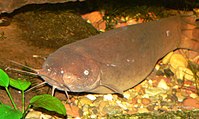BIOELECTROGENESIS
Bioelectrogenesis is the generation of electricity by living organisms, a phenomenon that belongs to the science of electrophysiology.
 |
| Electric eelThe electric eel uses electric shocks for both hunting and self-defense |
In biological cells, electrochemically active transmembrane ion channel and transporter proteins, such as the sodium-potassium pump, make electricity generation possible by maintaining a voltage imbalance from an electrical potential difference between the intracellular and extracellular space. The sodium-potassium pump simultaneously releases three Na ions away and influxes two K ions towards the intracellular space. This generates an electrical potential gradient from the uneven charge separation created. The process consumes metabolic energy in the form of ATP.
Bioelectrogenesis in fish
 |
| Electric catfish |
Bioelectrogenesis in microbial life
 |
| Northern Stragazer |
 |
| Electric ray |
- Electron shuttles in the form of redox-active compounds like flavin, which is a cofactor, are also able to transport electrons. These cofactors are secreted by the microbe and reduced by redox participating enzymes such as Cytochrome C embedded on the microbe's cell surface. The reduced cofactors then transfer electrons to the anode and are oxidized.
- In some cases, electron transfer is mediated by the cellular membrane embedded redox participating enzyme itself. Cytochrome C on the microbe's cell surface directly interacts with the anode to transfer electrons.
- Electron hopping from one bacteria to another in biofilm towards an anode through their outer membrane cytochromes is also another electron transport mechanism.
- These bacteria that transfer electrons in the microbe's exterior environment are called exoelectrogens.
Electrogenic bacteria are present in all ecosystems and environments. This includes environments under extreme conditions such as hydrothermal vents and highly acidic ecosystems, as well as common natural environments such as soil and lakes. These electrogenic microbes are observed through the identification of microbes that reside in electrochemically active biofilms formed on MFC electrodes such as Pseudomonas aeruginosa.
if you like this please follow me and leave a comment...
ReplyDeleteTHANK YOU...